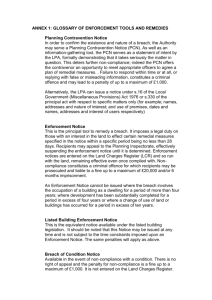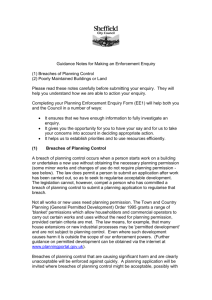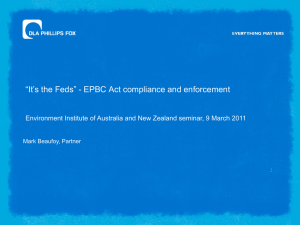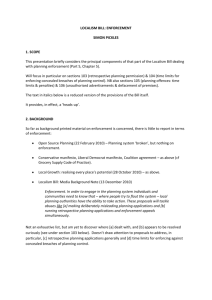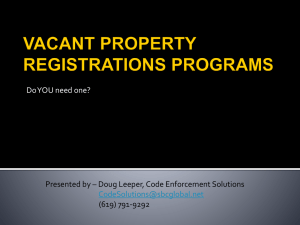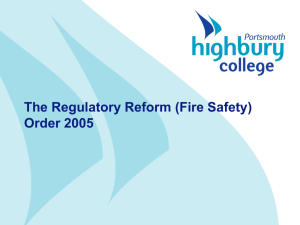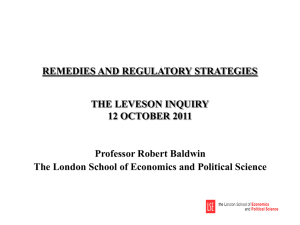UWE Planning Enforcement Conference
advertisement
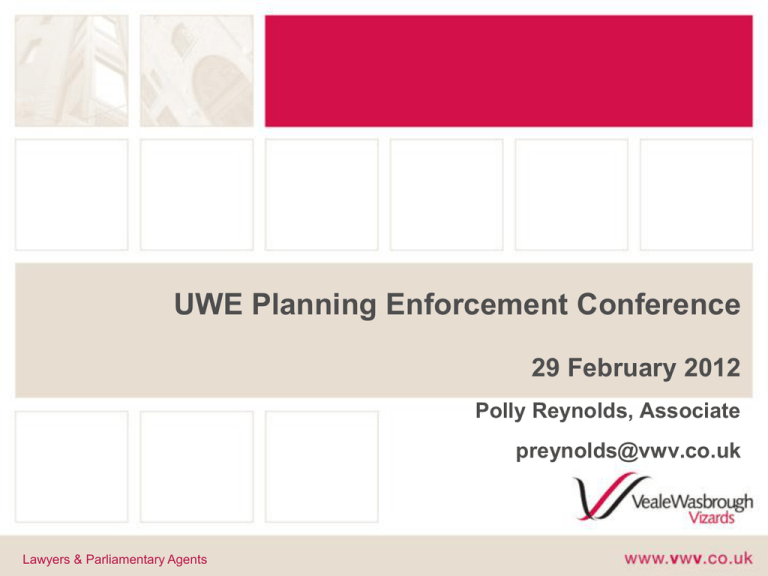
UWE Planning Enforcement Conference 29 February 2012 Polly Reynolds, Associate preynolds@vwv.co.uk Lawyers & Parliamentary Agents Planning Enforcement: What now and where next? Introduction • Overview of planning enforcement now (time limits/ when to take enforcement action). • Overview of key changes proposed and why under the Localism Act 2011. The current position – What is a breach of planning control? A breach of planning control may consist of: • Unauthorised development; or • Non-compliance with a condition of a planning permission. LPAs can take enforcement action against a breach of planning control provided they do so within the relevant statutory time limit. Powers to investigate possible breach of planning control • LPA has the right to enter land and buildings, at any reasonable time, without a warrant, to establish whether a breach of planning control has occurred. • Must have reasonable grounds: s196a TCPA 1990. • If entry to a dwelling, 24 hours’ notice must be given. • If access required to a residential garden/ outbuilding 24 hours’ notice not needed. Planning Contravention Notice • A PCN can be issued by an LPA to obtain information on possible breaches of planning control (s171C TCPA 1990). For model PCN see Annex 1 Circular 10/97. • Failure to comply with the requirements of a PCN within 21 days of the date of service and/ or knowingly or recklessly making a false/ misleading statement is a criminal offence punishable by a fine. What are the time limits? Section 171B TCPA 1990 • The 4 Year Rule: • Where breach of planning control relates to building/ engineering/ mining/ other operations (when “substantially completed”); or • Where there is a material change of use of any building or any part of a building to use as a single dwelling house • The 4 year period starts with the date of the breach. Time Limits continued • The 10 Year Rule: • Where there is a material change of use (other than a change of use to a single dwelling house); or • Where there is a breach of planning condition (except a condition relating to use as a single dwelling house). Taking Enforcement Actiondiscretionary • An LPA can take enforcement action where there is a breach of planning control and it is expedient to do so. • Guidelines: • Is it in the public interest? • Does the breach unacceptably affect public amenity or the existing use of the land? • PPG18: “usually inappropriate to take enforcement action against trivial or technical breaches of planning control which cause no harm to the amenity in the locality of the site”. • Personal circumstances (health and welfare) relevant • Human Rights Act 1998 – LPA must have regards to: • Article 1 – Protection of property; • Article 6 – Right to a fair trial; and • Article 8 – Right to respect for private and family life. The Infamous Enforcement Cases 1. Welwyn Hatfield Council v Secretary of State for Communities and Local Government [2011] UKSC 15 • 6 April 2011: Supreme Court judgement. • Inside Mr Beesley’s “barn” was a dwelling house comprising a gym, 3 bedrooms (2 of which were en suite). • A Certificate of Lawfulness sought after the family had lived there for 4 years on the basis that the building was lawful and immune from enforcement action. • Court of Appeal: Mr Beesley had established a change of use either from the use permitted by the planning permission or from a period of “no use” to that of a residential dwelling house. • Supreme Court: overturned the Court of Appeal’s judgement and unanimously held that: • • The building was not and had never been intended to be constructed as a barn and therefore there was no change of use; and • In any event, public policy dictates that Mr Beesley should not profit from his own dishonesty to obtain a Certificate of Lawfulness. The Supreme Court made it clear that the public policy point should only apply in the most extreme cases where the applicant has deliberately concealed the breach of planning control. The Infamous Enforcement Cases continued 2. R (on the application of Fidler) v Secretary of State for Communities and Local Government [2011] EWCA Civ 1159 The removal of the straw bales which concealed the dwelling were considered to be an integral part of the construction of the building and thus formed part of the building operations for the purposes of the 4 year time limit of enforcement action. New Enforcement Powers • The two cases highlight the difficulties LPAs face in trying to take enforcement action against concealed breaches of planning control. • The Localism Act (when it comes into force) will allow LPAs to take enforcement action where there have been deliberately concealed breaches - even after the statutory time limit for enforcement action has expired. • LPAs will be allowed to apply to a Magistrates Court for a Planning Enforcement Order (s124 LA 2011 (which inserts s171BA, s171BB and s171BC into TCPA 1990)). How is a Planning Enforcement Order made? • An LPA can make an application at any time within 6 months from the date in which there is sufficient evidence/ knowledge to justify the application. • Will be a prescribed procedure to follow. • A Magistrates Court can only grant a PEO in cases of deliberate concealment. • Extends time for taking enforcement action by an enforcement year (begins 22 days after Magistrates’ decision is made). Procedure for obtaining a PEO • Application to be made within 6 months of LPA having sufficient knowledge of concealed breach. • LPAs have sufficient knowledge “when LPA certifies they have sufficient knowledge.” • Must serve owner, occupier and any other person having a materially affected interest. • They are entitled to appear before the Magistrates Court. Section 171BC – Making the PEO The standard = balance of probabilities. “The actions of a person… have resulted in, or contributed to, a deliberate concealment of the apparent breach and the Court considers it just in all the circumstances to make the order” Problems? What comprises “deliberate concealment”? • No definition is given and no requirement for positive action to have been taken. • Deliberate concealment could, in theory, be any breach of planning control which a landowner is aware of and then fails to take action to remedy. • Difficulties in future applications for Certificate of Lawful Use – LPA could take that application as the coming to light of evidence of the apparent breach of planning control sufficient to justify an application for a PEO to be made. • Amendments were introduced to these provisions such that they were intended to be used in “the worst case scenarios” or breaches. flagrant Section 125 LA 2011 - “Letters of Assurance” • Section 125 introduces the new section 172A of the TCPA 1990 which will allow LPAs to serve a letter of assurance. • In order to receive a letter you would need to have been served with an Enforcement Notice. • However, under section 172A(2) of the TCPA 1990 the LPA can withdraw it at any time! What does an enforcement notice do? • Can require a wide range of steps to be taken within a specified period to: • Ensure the land is restored to the condition it was in before the unauthorised development occurred • Secure compliance with the conditions of a planning permission (s.171 TCPA 1990) • It does not by itself stop the breach of planning control from continuing - consider Stop Notice or BCN Right of Appeal and non-compliance • There is a right of appeal to the SoS. • Criminal offence not to comply with the requirements of a PEN. • Maximum fine £20,000 upon summary conviction or, upon conviction by indictment, an unlimited fine. Confiscation Order under PoCA 2002 • Following conviction of a criminal offence and specifically where there is non-compliance with a Planning Enforcement Notice, a Confiscation Order may be allowed to enable an LPA to recover any proceeds of crime. • If the court makes an order, the recoverable amount is equal to the defendant’s benefit from the conduct concerned. • Basso and Another v R [2010] EWCA Crim 1119: Confiscation Order of £760,000 made Any Questions? Polly Reynolds, Associate preynolds@vwv.co.uk Lawyers & Parliamentary Agents 01173 145 276
